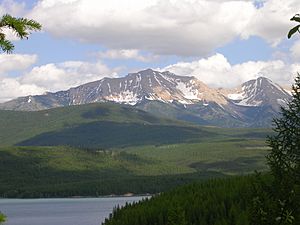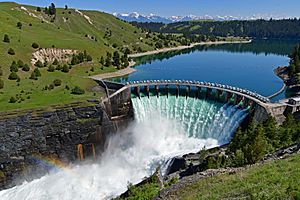Flathead Indian Reservation facts for kids
Quick facts for kids
Flathead Indian Reservation
Confederated Salish and Kootenai Tribes
|
|
|---|---|

View northeastward across Hungry Horse Reservoir onto the Flathead Range, Montana
|
|

Location in Montana
|
|
| Tribe | Confederated Salish and Kootenai |
| Country | United States |
| State | Montana |
| Counties | Flathead Lake Missoula Sanders |
| Established | 1855 |
| Headquarters | Pablo |
| Government | |
| • Body | Tribal Council |
| Area | |
| • Total | 5,020 km2 (1,938 sq mi) |
| Population
(2017)
|
|
| • Total | 29,218 |
| • Density | 5.820/km2 (15.076/sq mi) |
| Time zone | UTC-7 (MST) |
| • Summer (DST) | UTC-6 (MDT) |
| Website | cskt.org |
The Flathead Indian Reservation is a special area in western Montana, United States. It is home to the Confederated Salish and Kootenai Tribes of the Flathead Nation. These tribes include the Bitterroot Salish, Kootenai, and Pend d'Oreilles people.
This reservation is often called the Flathead Nation. It was created a long time ago, on July 16, 1855, by an agreement called the Treaty of Hellgate. The reservation covers parts of four counties in Montana: Lake, Sanders, Missoula, and Flathead. It also includes most of Flathead Lake. The Flathead Indian Reservation is a large area of mountains and valleys, covering about 1,938 square miles (5,020 square kilometers).
Contents
How the Reservation Was Formed
Native Americans have lived in Montana for over 12,000 years. The Salish and Kootenai tribes have a rich history in this area. The Salish are known as "the head or parent tribe" by their elders. Kootenai groups lived in different ways, some hunting bison and others fishing in mountain rivers.
In 1855, the U.S. government signed the Treaty of Hellgate with the tribes. This treaty set aside land for the Flathead people, including much of Flathead Lake. Later, the government decided to divide up tribal lands into smaller pieces for individual families. This was meant to encourage farming like European-Americans.
The Flathead people did not agree with this plan. However, in 1904, the U.S. Congress passed the Flathead Allotment Act. This law also allowed for the building of the Flathead Indian Irrigation Project. Many acres of reservation land were set aside for towns, schools, and the National Bison Range. Tribal families were given a choice of 80 or 160 acres of land.
The tribes had a treaty right to hunt outside the reservation. But the state of Montana tried to control these hunts. This led to a sad event in 1908, where four Native Americans were killed in what is known as the Swan Valley Massacre. Later, the U.S. Supreme Court agreed that the tribes had the right to hunt in their old territories.
After land was given to tribal families, the government said the remaining land was "extra." They then opened it up for white settlers to claim through homesteading. Many tribal members chose land near the mountains where wild animals still lived. This left good farmland in the valleys open for settlers.
When the land opened in 1910, many white settlers applied for parcels. This led to more land being taken from the tribes. The settlers started fencing land and using water from streams for irrigation. The U.S. government then built irrigation systems for these new homesteaded lands. The tribes asked for the Pablo National Wildlife Refuge to be created in 1921. They now manage the fish in the Pablo Reservoir.
How the Reservation is Managed
In 1934, the tribes formed a tribal council. They were the first tribes to create their own government under the Indian Reorganization Act. Over time, the tribal council took over managing many services. These included law enforcement, justice, forestry, wildlife, and health programs. The Flathead people have worked hard to get back control of their reservation lands.
The tribes also started managing the Mission Valley Power Company in 1988. This company provides electricity to the reservation. In 2015, the tribes bought the Kerr Dam, renaming it the Seli'š Ksanka Qlispe' Dam. This made them the first tribe to own a hydroelectric dam, which creates electricity for the area.
The Flathead Indian Irrigation Project was managed by the Bureau of Indian Affairs (BIA). It has 17 reservoirs and many miles of canals. In 2010, the tribes and non-tribal farmers worked together to manage the project. However, in 2014, the BIA took over management again. In 2020, the tribes made a new agreement with the state and federal government about water rights. This agreement helps the tribes manage water on the reservation forever.
Nature and Wildlife
Almost all of Flathead Lake is part of the reservation. The town of Polson is at the south end of the lake. The Flathead River flows through the reservation. The Mission Valley is in the middle of the reservation, surrounded by mountains.
Part of the Mission Mountains is on the reservation. The tribes protect the western part as the Mission Mountains Tribal Wilderness. The southern part has a large area for grizzly bears. This area is often closed to hikers to keep bears safe and avoid human contact.
The Natural Resource Department works to protect the many animals that live here. The tribe does not allow hunting of furbearing animals on the reservation. Non-natives can hunt certain birds like Hungarian partridge, pheasants, ducks, and geese. However, they cannot hunt animals like elk, white-tailed deer, mule deer, grizzly bear, or moose. Wolves, bison, swans, and falcons also live here.
In recent years, the number of native fish like bull trout and westslope cutthroat trout has gone down. There are also many non-native fish species in the waters.
In August 2023, firefighters worked to put out four wildfires caused by lightning. These fires burned over 16,000 acres.
People of the Reservation
In 2010, about 28,324 people lived on the reservation. About 9,138 of them identified as Native American. The largest town on the reservation is Polson. The main office for the Confederated Salish and Kootenai Tribes of the Flathead Nation is in Pablo.
Culture and Traditions
Bison are very important to Native culture and have a deep spiritual meaning. For a long time, the National Bison Range was managed by the federal government. But in 2022, after many years of talks, the site was returned to the tribes. This was a big step, as the tribes have strong ties to the land and the bison.
The tribe is also teaching members to grow traditional vegetables. They have at least eight gardens on the reservation. Some of these vegetables are used to make soup for tribal elders.
Economy and Businesses
The tribes earn money by selling timber and running different businesses:
- Gray Wolf Peak casino, located between Arlee and Evaro.
- KwaTaqNuk resort and casino in Polson. Its name means "where the water leaves the lake."
- S&K Technologies, a company that works with defense technology. Its main office is in St. Ignatius.
- S&K Electronics in Pablo, which makes electronics.
- S&K Holding, a company that helps with leasing and financing.
- Salish Kootenai College, a college run by the tribes in Pablo. It offers two- and four-year degrees.
Transportation and Power
The Mission Valley Power Company provides electricity to the reservation. The Seli'š Ksanka Qlispe' Dam also creates hydroelectric power for the area.
U.S. Highway 93 runs through the reservation. It is a busy road connecting Missoula to the south with Glacier National Park to the north. The tribes worked with the state to make improvements to this highway. They wanted to protect wildlife and their habitats. As a result, the project included 41 crossings for fish and wildlife. One of the most famous is "Animals' Trail," a wide bridge covered in plants, designed for animals to cross safely.
Places to Visit
- Flathead Indian Museum, St. Ignatius
- Flathead Lake State Park
- The Garden of One Thousand Buddhas
- Kicking Horse Reservoir
- Mission Mountains Tribal Wilderness
- Ninepipe National Wildlife Refuge and State Wildlife Management Area
- St. Ignatius Mission, St. Ignatius
- The People's Center, Pablo
Communities on the Reservation
There are 26 towns and communities on the reservation. Eight of these have a majority of Flathead tribal members. After the land was divided up long ago, white settlers owned about half of the reservation land. But since the late 1900s, the tribe has been buying back land. Today, the Flathead people own about two-thirds of the land on the reservation.
- Arlee
- Bear Dance (part)
- Big Arm
- Camas
- Charlo
- Dayton
- Elmo
- Evaro
- Finley Point
- Hot Springs
- Jette
- Kerr
- Kicking Horse
- Kings Point
- Lindisfarne
- Lonepine
- Niarada
- Old Agency
- Pablo
- Polson
- Ravalli
- Rocky Point
- Ronan
- Sčilíp
- St. Ignatius
- Turtle Lake
See also
 In Spanish: Reserva india Flathead para niños
In Spanish: Reserva india Flathead para niños






